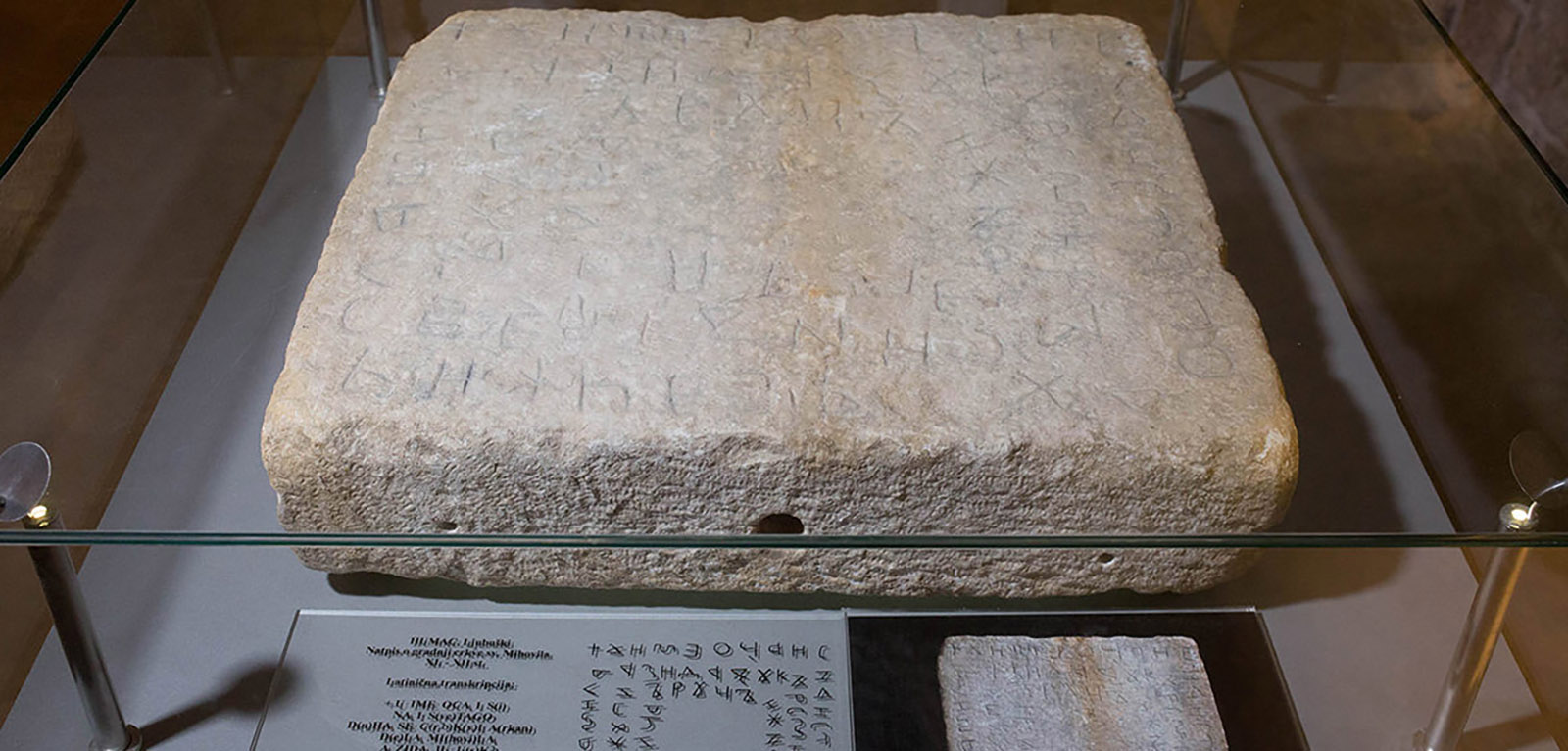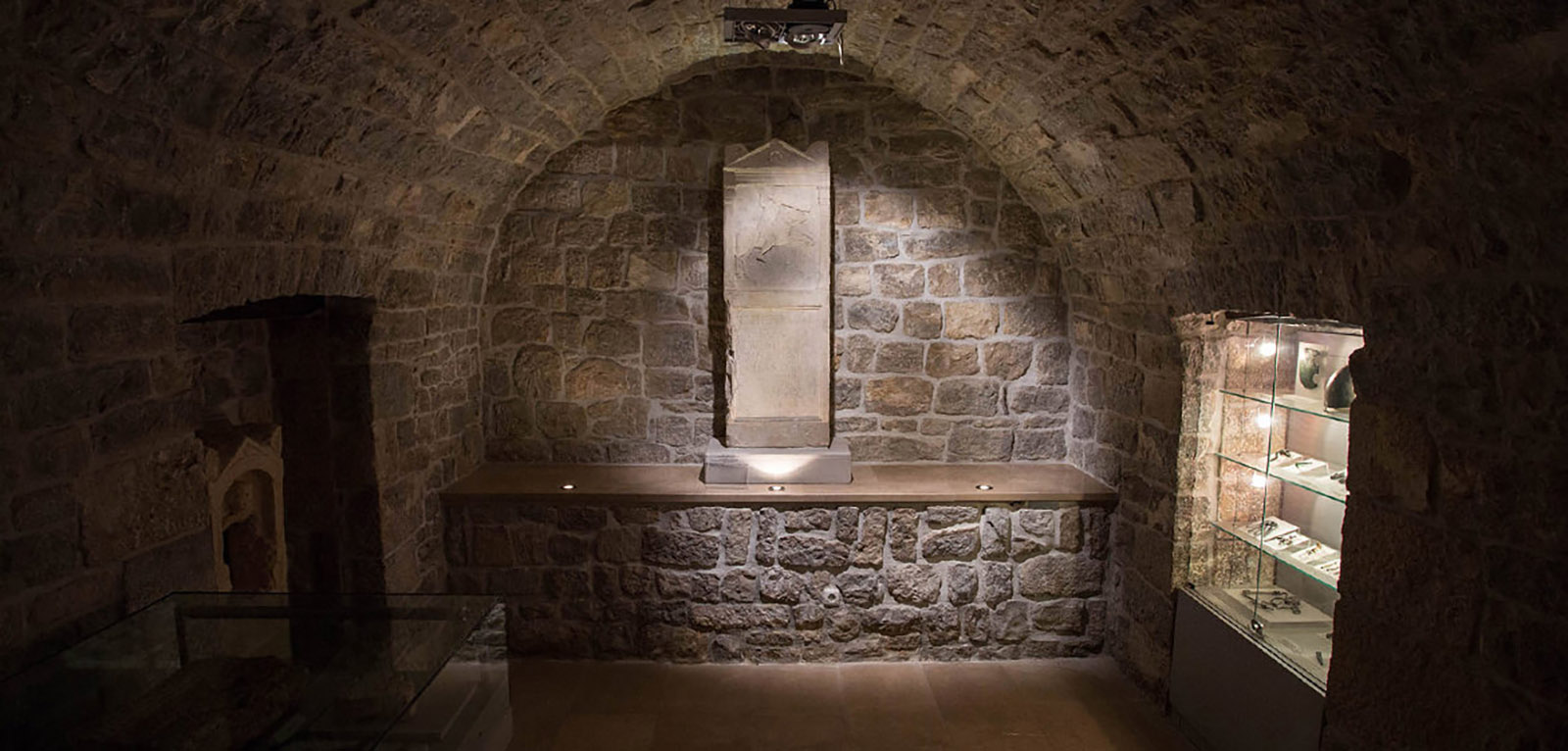+387 63 400 260
info@herzegovinabike.ba
BECOME A MEMBER/PARTNER
In the Franciscan Monastery of St. Anthony of Padua in Humac, you will find oldest museum in Bosnia and Herzegovina, established in 1884. In the restored museum, exhibits include artifacts collected from the broader region of Herzegovina, ranging from the Paleolithic era to the present day. The museum also displays the Humac Tablet from the 12th century, the oldest preserved monument written in the Croatian language (a mix of Glagolitic and Old Croatian Cyrillic – Bosančica) in present-day Bosnia and Herzegovina.
For generations, the Herzegovinian Franciscans have quietly collected, preserved, and studied the material traces of their country's past and the Croatian cultural and national identity in these regions. Since the establishment of the Herzegovinian Franciscan Province, there has been consideration of realizing the idea of Fra Petar Bakula (Batin, 1816 – Mostar, 1873) to open a museum that would also serve an educational role.
In the spring of 1884, Fra Anđelo Nuić converted a monastery room into the first museum institution in Bosnia and Herzegovina. The current museum space was renovated in 2002. The idea of establishing a museum emerged in the mid-19th century among the Herzegovinian Franciscans. Their studies at Italian and Austrian universities at the time, along with visits to museums where they could see some exhibits from their own region, coupled with the widespread lack of education and the scarcity of schools and cultural institutions, inspired the notion of founding such an institution locally.
Upon returning to their homeland and working in pastoral, cultural, and educational spheres—particularly after the separation from Bosnia and the establishment of the Herzegovinian Franciscan Province—they were able to contemplate the realization of the idea of opening a museum that would primarily serve an educational role. Preserving cultural heritage was not new to them. During the uncertain times of Ottoman occupation, they often had to carry church vessels, books, paintings, and other valuable items with them for safekeeping. While they had previously engaged in documenting, collecting, and preserving cultural-historical materials and natural specimens, this work took on more organized forms from the mid-19th century. Thanks to the efforts of certain parish priests and learned individuals of that time, numerous archaeological and other museum artifacts were collected at the monastery, which eventually guided researchers in discovering significant sites such as: the Roman agricultural estate (villa rustica) in Mogorjelo near Čapljina, the Roman military camp Gračine on Humac, the stratified archaeological site in Gorica near Grude, and many other extensively unexplored sites, such as the Roman settlement in Gračac near Posušje.
The first major step towards realizing the idea of establishing the museum was made by the historian, writer, and builder fra Petar Bakula (Batin, 1816. – Mostar, 1873.). ChatGPT said: ChatGPT In 1867, he published his Schematism in Latin, in which he presented his observations and research in fields such as archaeology, history, historical topography, ethnology, and natural sciences. His work became the foundation for more serious research into the past, and despite later indiscriminate construction, the information it provided remains relevant today. Fra Anđelo Nuić (Drinovci, 1850 – Mostar, 1916), an archaeologist, conservator, and museum curator, deepened Bakula's knowledge of history and archaeology. He conducted the first field archaeological investigations, discovering the Roman military camp at Gračine on Humac, and the remains of Roman buildings and stone monuments with inscriptions at Karaula in Tomislavgrad. The portable archaeological finds he obtained through fieldwork, purchases, and donations were transported to the monastery rooms at Humac with the intention of exhibiting them to the public. He secured a room in the monastery, had display cases made, and in the spring of 1884, he opened it to the public, thus establishing the first museum institution in Bosnia and Herzegovina. That same year, he drafted the museum's statute and began maintaining the museum's register, or the logbook of collected items.

You are now presented with a completely new museum exhibition featuring archaeological artifacts collected from the broader region of Herzegovina. These items span a wide historical period. The first stage of prehistory, the Old Stone Age (Paleolithic), is represented by just The exhibition includes artifacts from a broad range of historical periods. The Old Stone Age (Paleolithic) is represented by a single exhibit. Subsequent periods include the Neolithic (New Stone Age), the Copper Age (Chalcolithic), the Bronze Age, the Iron Age, as well as Roman, Late Antique, and Medieval times, with the available number of artifacts. This extensive time span of approximately 16,000 years is not equally represented in the museum's collections. The oldest periods of prehistory and the Middle Ages are less represented, so the exhibition includes nearly all the items from these earlier times that the museum holds. For other archaeological materials, a selection of the most representative remains of material culture has been made. The Roman collection is particularly rich, due to the fact that the Ljubuški area is renowned for its numerous monuments from this period.

This exhibition of archaeological artifacts from the broader region of Herzegovina provides visitors with at least a superficial insight into the material and spiritual culture of the inhabitants who have lived on this land over a long period. It also reveals the lesser-known efforts of the Herzegovinian Franciscans, who for generations have diligently and quietly worked on collecting, preserving, and studying the surviving material traces of their country's and their people's past.
The Franciscan Monastery of St. Anthony of Padua in Humac houses the oldest museum in Bosnia and Herzegovina, established in 1884. It also contains the Humac Tablet from the 12th century, the oldest preserved monument written in the Croatian language (a mix of Glagolitic script and Old Croatian Cyrillic – Bosančica) in present-day Bosnia and Herzegovina.
Thanks to the collecting activities of numerous Franciscans and various donations from the local population, the collection has continuously expanded, as has the need for new spaces for the archaeological collection. The current museum setup, established in 2003, is located in the basement rooms of the Franciscan Monastery of St. Anthony of Padua in Humac. The archaeological material, collected from the broader region of Herzegovina, is divided into prehistoric, ancient, and medieval periods, spanning nearly 16,000 years. The complex also includes a lapidarium for the display of stone monuments, located in the monastery courtyard.
In the Ljubuški region, 70 Roman monuments have been discovered, with the majority being funerary stelae dedicated to veterans and soldiers from various legions and auxiliary units. The museum displays the oldest Cyrillic-Glagolitic monument, which commemorates the restoration of the Church of Archangel Michael in the 11th/12th century, popularly known as the "Humac Tablet." The Humac Tablet is the oldest written monument of Croats in Bosnia and Herzegovina.
Within the Franciscan Monastery of Humac in Ljubuški, the art collection with its permanent exhibition titled "Mother" was opened in 2004. The idea for the establishment of the collection originated from dr. fra Ljudevita Rupčića i dr. fra Viktora Nuića. The two individuals decided in 2001 to establish a collection as a joint donation to the monastery in Humac. Over the course of three years, the collection expanded significantly. Thanks to donations from generous people, the former library space was thoroughly renovated, and the collection, enriched with artworks of necessary artistic quality and supported by sponsors, was formally opened. The collection includes approximately 250 artworks, with nearly 140 sculptures in various materials, and the remainder consisting of paintings, drawings, and prints.
Rupčić's book "Mother", which has since been published in six languages, together with Zvjagin's paintings, was the reason for the creation of this collection. However, the main motive for creating and presenting this collection to the public is to give importance to the woman, the mother, to deepen the meaning of motherhood, the transmission of human life according to the Creator's plan, as well as life itself - values that in our time are experiencing an unprecedented decadence. Art can contribute to the respect of these values, so this is the most important reason for the decision to create a collection of such a theme. The judgment of this collection should not be based only on the artistic value of individual exhibits, but on the message it conveys as a whole. Artistic impressiveness is very important, but so is supporting a noble idea - nurturing the great theme of women, glorifying her self-sacrifice, love for man and devotion to God
The art collection in the Franciscan monastery in Humac has an interesting concept. It brings together artists around the magnificent theme of the mother. Frequent inspirations of sculptors and painters throughout history... From the depiction of our heavenly mother to a simple woman, the bearer of life, shown in everyday life situations. The divine mother is depicted in the glory of the altar, but also in participation in Christ's suffering, in the pain of the laid body of her son. And in the warmth of love with the still small child Christ. Croatian artists of different generations, about seventy of them, who were inspired by this great theme, are represented at Humac. From the classics who were active at the very beginning of the 20th century, and in its first half, to established names of recent Croatian art. The sculptural section of the collection is a more significant part, and a representative selection of authors, shown either with one sculpture or with a larger number of works, so you get retrospective indications of their works. The more dominant the sculpture is to some extent understandable, because sculptors often reach for this theme.
But without a doubt, the painters also gave their valuable achievements, conveying their experience of the mother with full artistic excitement through the personality of the poet. The collection has a sacred atmosphere. And in two ways. Through the representation of the Mother of God, but also the dedication to the motherly calling of all women. Through their eyes, the artists interpreted the mother at work, playing with the child, combining personal experiences and the universal concept of mother. Approaching work with joy, love, respect. In the ranges of stylistics, from realistic indolence, stylization of forms, expressive movement, to reduction of form. In works with a strong emotional charge, in which the nobility of the character comes to the fore. A constant touch of outer and inner beauty. The search for the divine in man.
Opening hours of the museum?
The museum is open for visitors every day, from October 1 to March 31, working hours from 10 a.m. to 5 p.m., or from April 1 to September 30 with slightly longer hours from 10 a.m. to 7 p.m.
Tickets?
That. You can buy them as an individual ticket for the Museum on Humac at a price of 2 KM (for the period from 1.1. to 15.6. / 15.9. to 31.12) or 4 KM during the summer season (for the period from 15.6. – 15 September), or at the Kravica waterfall site in a joint package.
What is on display in the museum?
The museum exhibits items collected in the wider area of Herzegovina, which chronologically belong to the period from the Upper Paleolithic to the late Middle Ages, in a time span of almost 16,000 years. The most numerous collection of finds consists of objects from the nearby Roman military camp in Gračina, which was investigated in the period from 1977-1980. year. The Museum also exhibits the so-called The mound plate, which we date to the period from the 10th to the 12th century. century, and represents the oldest written trace of the Croatian language in the territory of today's Bosnia and Herzegovina.